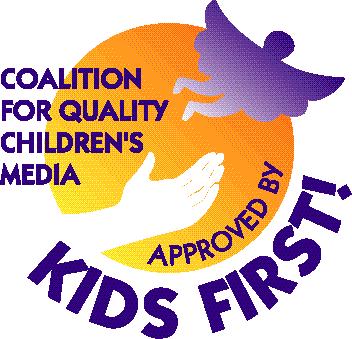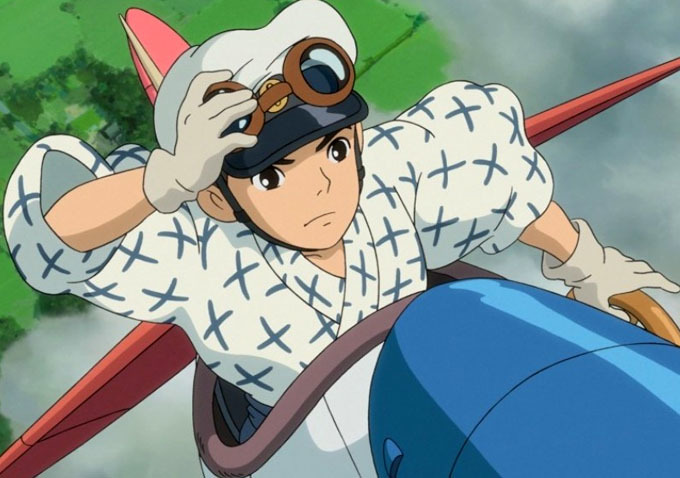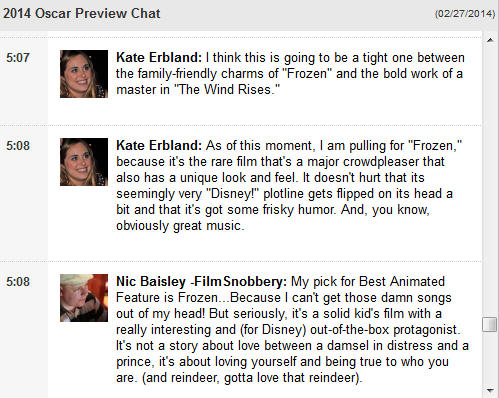 With so much Oscar chat about Frozen putting all other animation contenders on ice, I thought I’d “get beyond the buzz” of school, social media and neighborhood chatter to ask kids who are trained as media critics by the KIDS FIRST! Coalition For Quality Children’s Media, a 501c3 nonprofit.
With so much Oscar chat about Frozen putting all other animation contenders on ice, I thought I’d “get beyond the buzz” of school, social media and neighborhood chatter to ask kids who are trained as media critics by the KIDS FIRST! Coalition For Quality Children’s Media, a 501c3 nonprofit.
After an extended chat with Ranny Levy, Founder and President of KIDS FIRST! about the overlap in our missions to teach kids critical thinking skills, I’m excited to say we’re creating a simple distribution alliance.
Since I’m eager to get more young voices in the mix and have a reliable group of kids that can field questions about media and marketing’s impact on kids, and she’s already hosting 22 of them as national youth reporters ages 7 to 16 from a wide array of regions who have met core criteria for analysis, it’s a fast-track puzzle piece fit for mutuality.
 Known for their Film Festival work for over 14 years, KIDS FIRST! reviewers also air their content on the Voice America Kids weekly internet radio show boasting 4+ million listeners (live every Tuesday at 4pmET then archived 24 hours after; heads up though, there’s auto-audio with volume on that link!)
Known for their Film Festival work for over 14 years, KIDS FIRST! reviewers also air their content on the Voice America Kids weekly internet radio show boasting 4+ million listeners (live every Tuesday at 4pmET then archived 24 hours after; heads up though, there’s auto-audio with volume on that link!)
They seem truly committed to giving youth a voice as curators with guidelines for consistency and opportunities to speak out untethered, so this could be all kinds of fun…We’ll see what works out, but for now, I’m glad to see young reporter’s recruitment far beyond a ‘fame game’ focus of celebrification and red carpet hoopla as reading through the participation and feedback from parents, it seems like the written and oral skills gleaned by these kids have been invaluable already.
From their site, what it takes to be a Junior Film Critic, with some of the 10-week online curricula/evaluation criteria:
1. Define and experience the role of a media critic.
2. Learn to tell the difference between what is real and what is not real in media.
3. Understand the impact of media violence on behavior.
4. Explore the difference between gratuitous and non-gratuitous violence.
5. Recognize unsafe and unkind behavior in media and the harmful effects it can have on viewers.
6. Recognize stereotypes and understand their inaccuracy, unfairness, and prejudice.
7. Use a method of evaluation and a set of criteria to judge a piece of media.
8. Assess a value on media, using a star-system, based on a set of criteria, personal experience, and opinion.
I’ve often used working drafts of Hollywood screenplays to demo writing styles to students in order to achieve ‘authentic dialogue’ so those who might want to prep their skills in youth reporting for the school paper, work on theatrical delivery, think about being a guest contributor or intern, or apply to the KIDS FIRST! team could use their guidelines to see what it takes to hone this talent and skill set.
I thought I’d share some of the KIDS FIRST! format parameters in a “go ahead, try this at home” practice run for parents, educators, after school programs.
Try it? It’s a great writing exercise to get kids thinking about content in depth.
Format for reviewers (appx 400 words):
• In the very first sentence, write a short sentence telling how well you liked or didn’t like the film. Use your own words and make them interesting. I.e. This film is so funny, I found myself laughing so hard I thought I would cry.
• Next, tell us why you did or did not like it. Whenever you make a generalized statement, you need to give specific examples of why you said that. If this film is hysterically funny, say what makes it so funny. i.e.. Steve Martin’s portrayal of the Dad reminds me of my own Dad in his sillier moments. The way he walked adds to the humor.
• Talk about what happens in the film but don’t tell or give away the ending. Describe the film as if you are describing it to a friend who has never seen it. People who read your review have not seen the film yet and their decision to see it might be based on what you say. That’s the role of a film critic.
• Describe your favorite or least favorite parts of the film and say what you liked or disliked about them. Give specific examples.
• Describe the talent and their performances. Use the internet movie database (imdb.com) to get the correct spelling for the names of actors in the film. Describe your favorite characters and who plays them. Tell us what makes their performances memorable.
• Tell us the message of the film. Is there a moral message? Something that makes you think a bit more deeply about life? What is it? If you can relate to is, tell us why.
• Talk about things that stick out in your mind such as the music, sets, costumes, script, make-up or the animation. These are important aspects that make films stand out. Tell us about them.
• Wrap it up at the end. Tell us who the audience is and why. What age would enjoy this? Does it have universal appeal or would boys like it better than girls or vice-versa?
• Rate it. We use a 1 to 5 star rating. How many stars would you give this?
This year, IndieWire calls the animation category nominees collectively,
“One of the best representations of contemporary feature-length animation since the category’s inception…The list of nominees for best animated feature showcase a diverse range of sensibilities: three studio movies with varying commercial traditions in play, a 2-D French-produced adaptation of children’s book, and a mature Japanese biopic from one of the masters of the medium.”
Here’s “what the kids say” about the 2014 Oscar nominees.
Of the five Academy Award nominees in animation, the only one not yet covered yet by the KIDS FIRST! team is Ernest & Celestine which just premiered at the new Sundance Kids 2014 division. For more about Sundance 2014, see our post about family narratives and fresh perspectives coming to the screen soon…
The Croods: Reviewed by Cheyenne Nguyen, age 9
A few pullquotes from Cheyenne about The Croods:
“This movie is about a family adventure that gave me tears and joy. A caveman and his family are forced to change because the earth is changing. They Croods are the last prehistoric family left to fend for themselves against the animals and elements. Everyone in the family goes by the simple rule “Fear keeps us Alive.” The family hunts for food, including the super hyper 4-year-old Sandy…”
“…I like the way they make Eep look like a normal healthy girl instead of a skinny “princess” like girly look. They make Guy a super skinny dude who needs belt to hold up his pants. My favorite part of the movie is when the family escape from danger – Grug always counts and makes sure everybody is safe. He likes to stop at 4 but Gran always come out alive as number 5″
“…The special effects in this movie are so great. You can see the landscape, rocks and lava as if they are real. The 3-D effects makes everything so close that you want to reach out your hands to touch it. The cinematography shows how beautiful the earth is. It is filled with rocks, beautiful bright flowers, lush jungle, bright stars and the sun. There are so many different animals in this movie. All the animals are so detailed with colors, feathers, stripes and they are all so cute, even the dangerous ones.”
“…The only part I did not like is when the creatures are trying to catch the family for food. This part with 3-D effects seems too real with all the sharp teeth and claws. I was so scared when the claws come out so sharp and so close to you. The message in this movie is to face fear and accept changes. My favorite character is Sandy. She is a hyper creature in this very cute baby body. She’s a great hunter and so cute. I give this movie 4 out of 5 stars and recommend it for ages 6 to 18.” –Cheyenne Age 9
The Wind Rises, Reviewed by Keefer C. Blakeslee, age 13
 A handful of Keefer’s outtakes: “This is a breathtaking masterpiece of art that allows your mind and heart to soar like the wind…”
A handful of Keefer’s outtakes: “This is a breathtaking masterpiece of art that allows your mind and heart to soar like the wind…”
“The voice acting is well done. I think they portrayed the characters and their relationships exceptionally well. Much of the film focuses on the romance between Naoko and Jiro. Their connection is both loving and tragic. The film was first released in Japan, so American voice-overs are dubbed over the animation and yes, it can be distracting. They confront actual events that happened in Japan, such as the Kanto earth-quake of 1923 and Japan entering the war. “
“I love the truth in this film. It doesn’t shy away from talking about the real issues that happened during this time…My favorite scene is the last dream sequence, after Jiro goes through a life changing experience. This is one of those bitter sweet endings, where you don’t know what to think at first. You just need to take it all in. The message in this film is, “Sometimes the outcome to your dream is not always what you expect.” –Keefer, Age 13
Of note, a younger reviewer, Gerry O. age 11, scales up the age a tad: “I recommend this movie for ages 13 -18. It is very mature and contains a lot of adult concepts that younger kids may not understand or appreciate. I also give it 4.5 out 5 stars.”
Despicable Me 2 has several KIDS FIRST! review videos posted (all ages) For range, I’m pulling this very polished public speaking teen presenter, as she has been serving as a junior film critic for a couple of years now judging by this list, and is clearly ‘red carpet ready’ in familiarity with media presence:
Despicable Me2: Reviewed by Raven Devanney, age 15
For Frozen, I chose to feature an 11 year old boy’s review of the film, but also recommend you check out this 17 year old high school boy’s take on Frozen too, (a guest post on media literacy colleague Dr. Jennifer Shewmaker’s blog) as the teen articulates the creativity, empathy, and sensitivity of the breakthrough gender portrayals that this film is being applauded for in terms of breaking out of the formulaic ‘cookie cutter’ mass media box.
Frozen: Reviewed by Gerry Orz, age 11
While some film critics are banking on The Wind Rises as an artistic ‘given’ for an Oscar nod from The Academy (especially given the bittersweet retirement of anime great Hayao Miyazaki) I asked the opinions of the pros in this extensive #OscarChat conversation with film critics on Twitter yesterday…(click on link for their bios and backgrounds) Specifically, I asked, “What’s your pick for the animation category and why?”
As you can see by their replies, Frozen is in a “unique as a snowflake” position to break through as the inventive, wildly successful global box office hit that marks a ‘sea change’ to start breaking gender stereotypes and hopefully start to ‘see change’ in more nuanced scripts and characters…
I wrote a bit about Frozen in a media literacy context on assessing personal bias here and will be doing a follow up on the social emotional learning and ‘teachable moments’ using the film as an ‘icebreaker’ to connect with youth on touchy topics, from the dismissive pain of being “dismissed” for no apparent reason (relational aggression in the school yard) to the death of parents or the ‘bait and switch’ personas of behavior that seems “too good to be true.”
Will Frozen swirl into the Oscars like a “Polar vortex” and freeze out everything else, winning best song for the popular “Let it Go” as well?
As the KIDS FIRST! tween tribe said, “Tune in and find out.”
Great to see so many worthy offerings…
“For your consideration…”
 The Oscars are a perfect opportunity to blend youth voices with fun ways to engage kids with media, film and critical thinking, like the New York Times “film in the classroom” learning blog and Frank Baker’s “learning from the Oscars” lesson plans…
The Oscars are a perfect opportunity to blend youth voices with fun ways to engage kids with media, film and critical thinking, like the New York Times “film in the classroom” learning blog and Frank Baker’s “learning from the Oscars” lesson plans…
Ever amazing media literacy educator Frank Baker has also created two new helpful web sites recently: Teacher’s Guide to the Academy Awards and the Language of Film carrying forth his excellent recommendations in videos, lesson plans and more. Check ’em out…Meanwhile, I look forward to teaming with the KIDS FIRST! youth reporters “on assignment,” interviewing about Shaping Youth topics, too…Roll ’em!
The Oscars: Teaching Tools From the NY Times Learning Blog:









Speak Your Mind